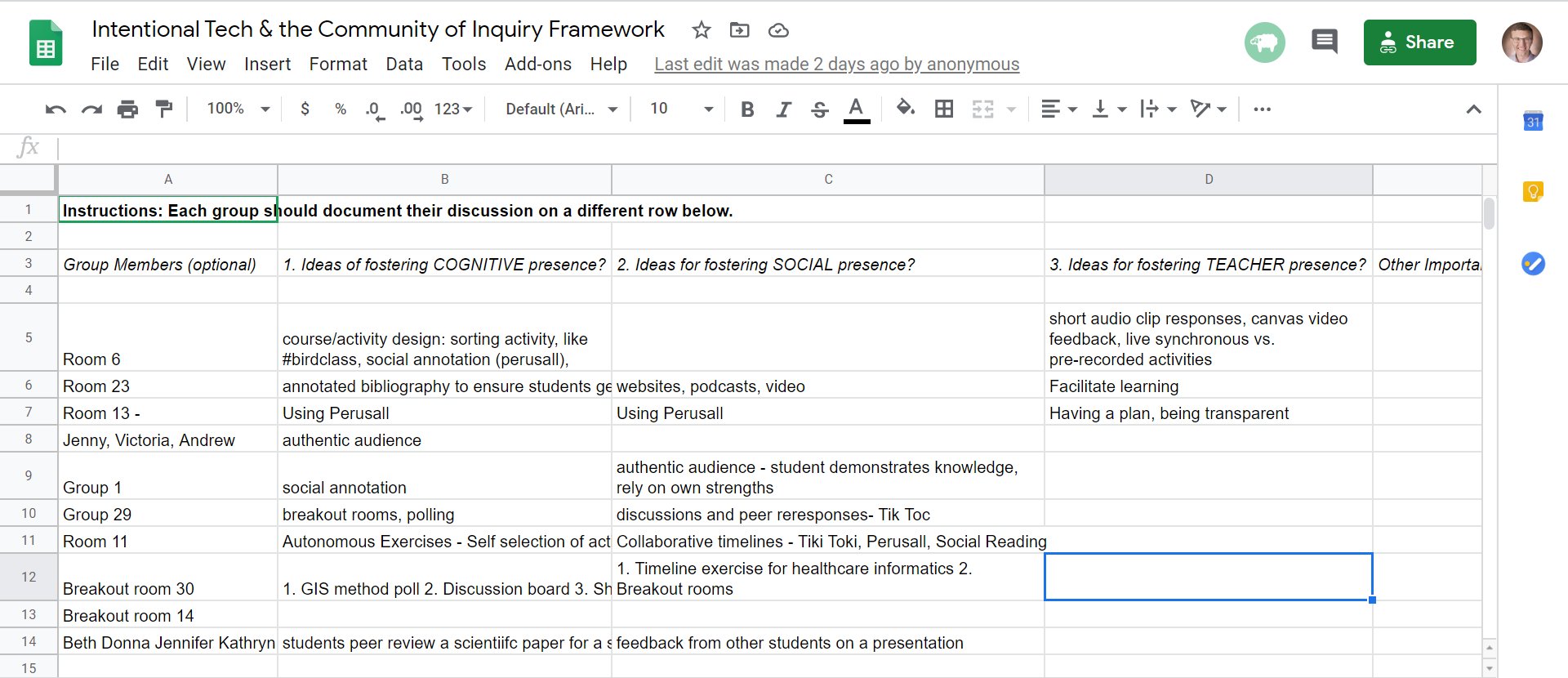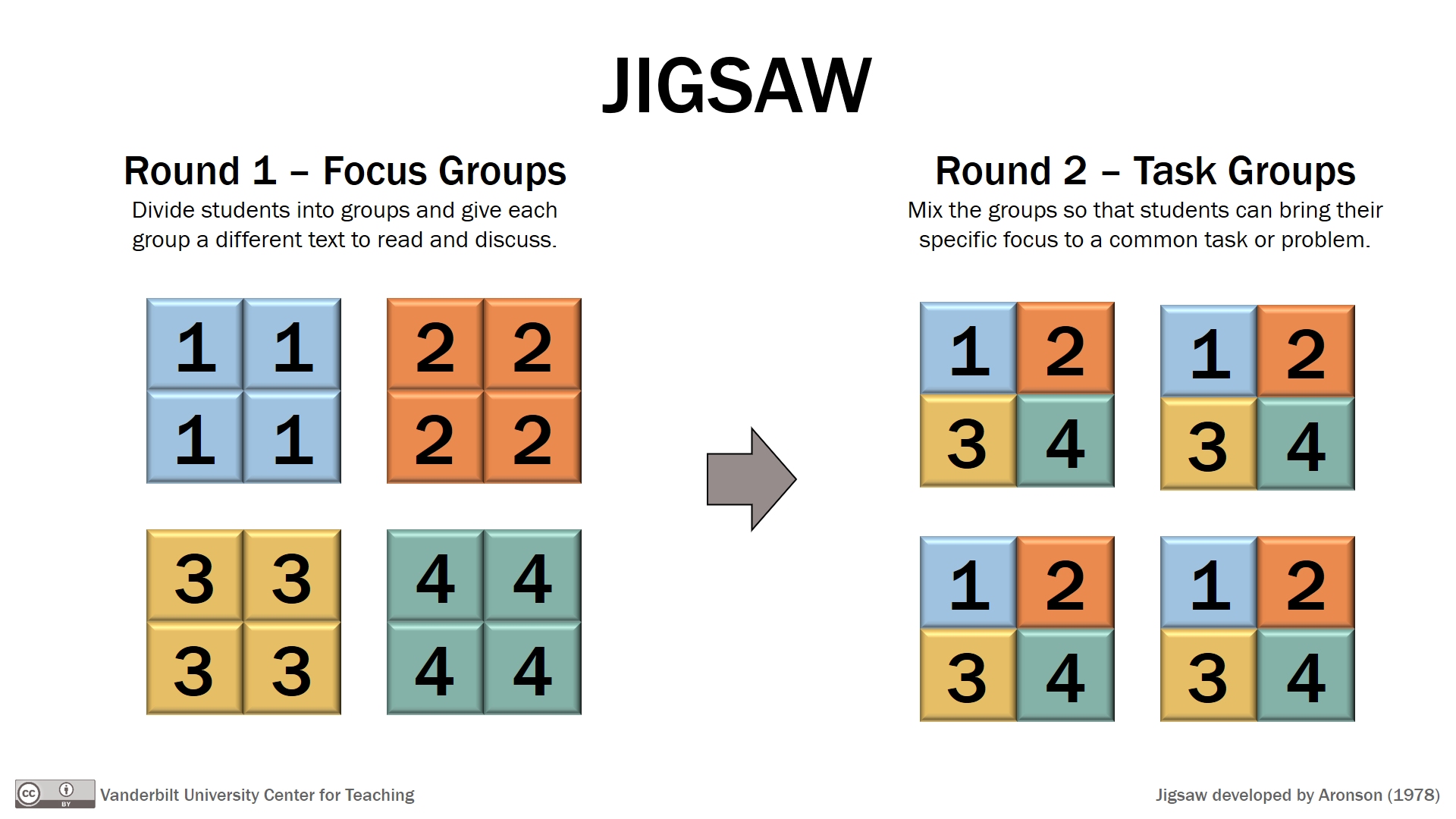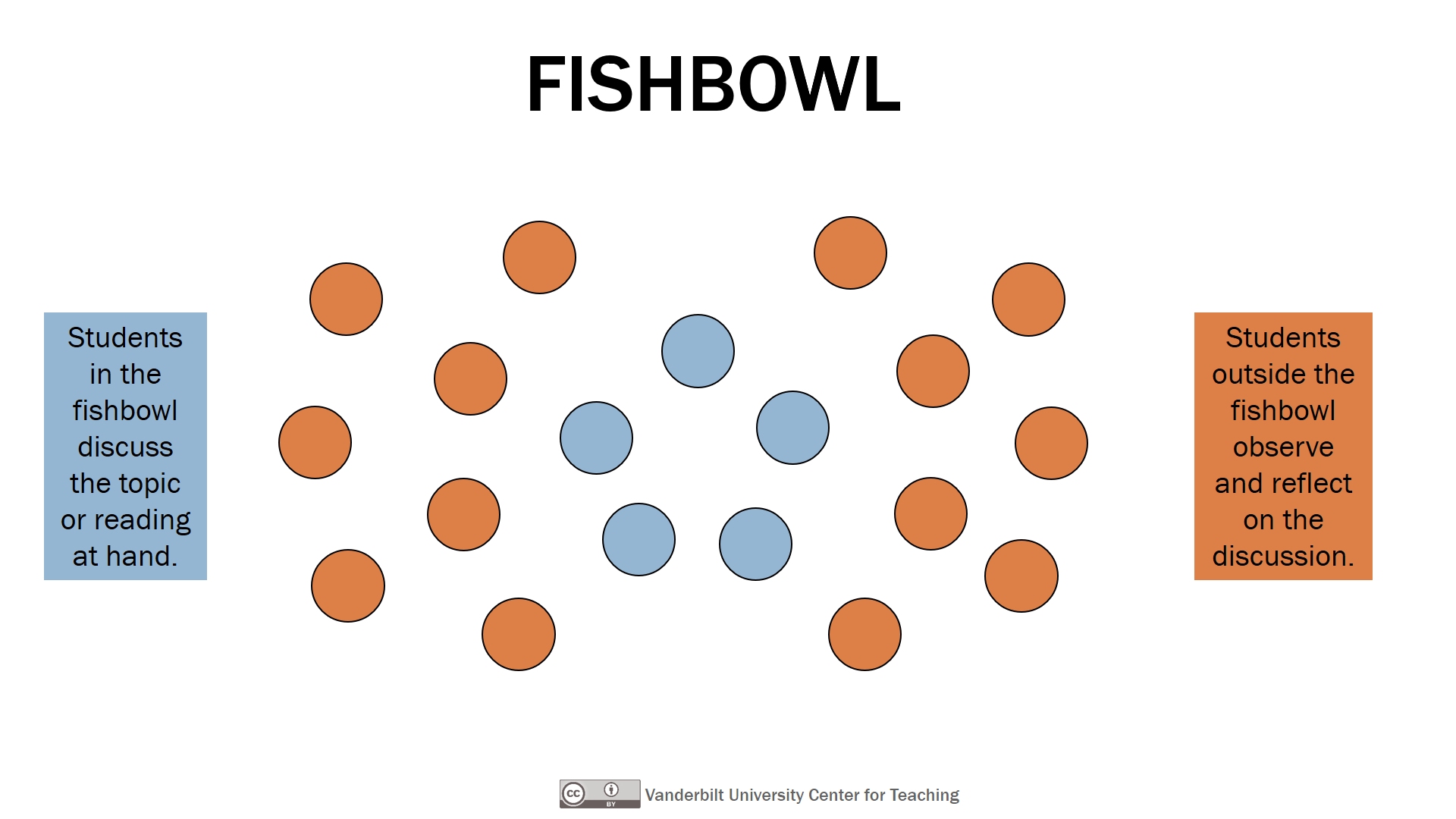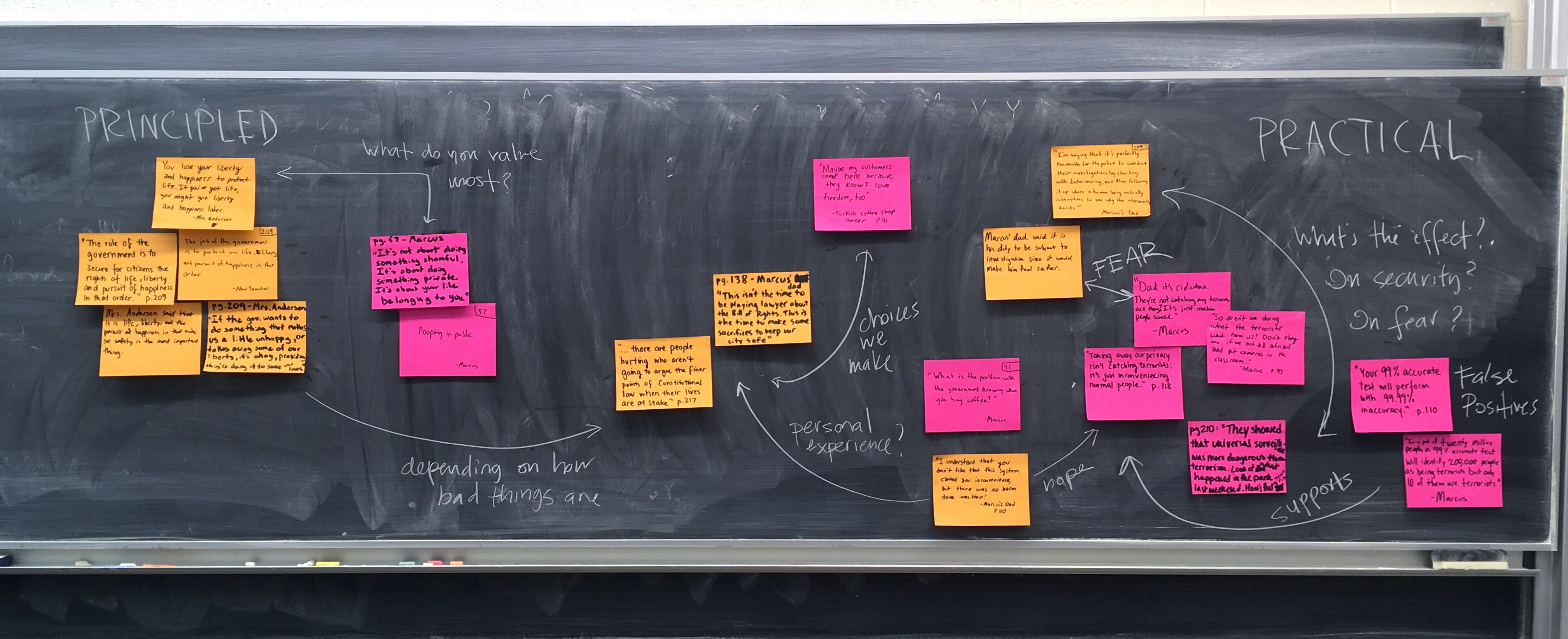
Teaching Strategies
Strategies for Teaching in SMUFlex:
The strategies below are adapted from a blog post by Derek Bruff from Vanderbilt University.
Classwide Discussion
This may be one of the more challenging activities to conduct in a hybrid and socially distanced classroom. Why? It will likely be hard for the students participating virtually to hear contributions made by students participating in-person. The virtual students will presumably be able to hear the instructor through a microphone, but without extra microphones to pick up the voices of the students in the room, it’s not clear how the virtual students will hear the in-person students. Some rooms may have the audio equipment to pick up in-person students, but many classrooms won’t have that kind of gear and it’s not clear yet how well those extra mics will work for students who may be speaking through masks.
Could students in the room use their laptops or phones to participate in the videoconference? Given some preliminary testing done by the Pepperdine University Center for Teaching Excellence this might be challenging. They found that having multiple people in the same room on the same videoconference led to unpleasant audio feedback. However, social distanced space between students and asking each student to bring headphones and using Zoom breakout sessions makes this option much for feasible and fruitful.
Live Polling
One simple way to engage students in the room and on the Zoom call is to use a live polling tool to ask them questions about the course material. Back in the day, we used “clickers” for this type of live polling, but these days we have lots of options for classroom response systems. One option would be to use whatever polling feature your videoconferencing tool provides. Zoom polls, for instance, let you ask multiple-choice and multiple-mark questions pretty easily. This would mean your in-person students would need to be in the Zoom session, which has advantages. But if your Zoom screen is getting too busy, you could have your in-person students turn off their cameras; Zoom can hide participants who don’t have their cameras on.
If having your in-person students in the videoconference is hard, or if you’d like to ask more complex questions (free-response, clickable image questions, and so on), you could shift to a second platform like Poll Everywhere or Top Hat. This adds a little overhead for instructors and virtual students (now you have to manage, say, Zoom and Top Hat windows), but if you’re going to use polling regularly, that learning curve might be worth it.
Backchannel
The text chat that likely comes with your videoconferencing tool can be used to host what is called a backchannel for class discussion. The spoken dialog between you and your in-person or online students forms the “frontchannel,” while the text chat provides a forum for supplemental discussions among students. A backchannel can be useful for fostering dialog and even a sense of community among your in-person and online students. It can also serve some universal design purposes by providing a written alternative to spoken discussions or an ad hoc text captioning of spoken conversations.
Note that, as with live polling, if your videoconferencing tool’s built-in chat tool isn’t suitable, you could add a second platform like Slack, Discord, GroupMe, or Microsoft Teams. These platforms can also be useful outside of class time for less formal communication among students and instructors. Note also that for some videoconferencing platforms (e.g. Zoom), if a student drops the call and then re-enters the session, they lose the earlier text chat, which is another reason to use a second platform.
 Monitoring and responding to the backchannel can be a challenge for instructors, of course, whose attention can only be split so many ways. I recommend appointing someone to be the “voice of the chat.” This person could be a rotating student or a teaching assistant or a faculty colleague (maybe you can return the favor in their class). Their job is to monitor the backchannel and look for questions or comments that should be brought to the attention of the instructor. I like to plan “voice of the chat” moments in my lesson where I call on this person to speak up and share these questions and comments, and I’ll even signal these moments in my slides, using a graphic like the one seen here.
Monitoring and responding to the backchannel can be a challenge for instructors, of course, whose attention can only be split so many ways. I recommend appointing someone to be the “voice of the chat.” This person could be a rotating student or a teaching assistant or a faculty colleague (maybe you can return the favor in their class). Their job is to monitor the backchannel and look for questions or comments that should be brought to the attention of the instructor. I like to plan “voice of the chat” moments in my lesson where I call on this person to speak up and share these questions and comments, and I’ll even signal these moments in my slides, using a graphic like the one seen here.
It’s a good idea to talk with your students about how to use the backchannel productively during class sessions. You might want to establish some community norms about appropriate text chat use. You might also want to direct students’ contributions to the backchannel with some guiding questions. For some ideas, see a 2010 blog post “Backchannel in Education – Nine Uses.”
If audio is a challenge in your fall classroom, that is, if it is hard to hear students who are socially distanced and wearing masks, then the backchannel + voice of the chat combo might be particularly useful. If you have a microphone to share with your voice of the chat, you could invite all students to share their questions and comments on the backchannel, then rely on the voice of the chat to vocalize those questions with you and the entire class using the mic.
Collaborative Notetaking
A variation on the backchannel approach is collaborative notetaking. This typically involves setting up a Google Doc for students to use during class to take notes on the class discussion. Often, two or three students are appointed lead notetakers for a given class session, with that duty rotating among students over the semester, but all students are invited to read and contribute to the shared notes.
This approach provides a structure for active listening during class–notetakers don’t participate in the discussion but try to capture all of it they can, while the rest of the students can focus on participating in discussion without having to worry about taking notes–and might be particularly valuable in a classroom where it is hard to hear some students, especially if the notetakers are scattered throughout the socially distanced classroom..
Group Work
Live polling, backchannel, and collaborative notetaking are useful activities that don’t require students to leave their physical or virtual seats. But what about group work in a SMUFlex classroom where the in-person students aren’t free to move around the classroom? Let’s consider a possible scenario:
You have three discussion questions for your students to consider in small groups. Under normal circumstances, you might have posted these questions in a PowerPoint slide or included them in a printed handout. In your SMUFlex classroom, however, you’ve put your three questions at the top of a Google Sheet, one question per column. You ask your students to get into groups of two or three, with the in-person groups sitting six feet apart from each other at tables and your online students moving to breakout rooms in your videoconferencing platform. You give your students some time to discuss the questions in groups and report their answers using the Google Sheet, with each small group selecting an unused row of the spreadsheet to document their answers.
Ordinarily you might circulate among your students as they work to eavesdrop and ask a few questions. That’s not feasible now, but the Google Sheet serves a similar purpose. As the students work, you keep an eye on the sheet, monitoring your students’ progress through the activity (so you know when to call time) and getting a sense of their responses (so you can plan the debrief at the end of the activity). When the group work is over, you highlight a few student responses to share with the full group (either yourself or by asking the loudest group member to speak) along with your comments reflecting on and synthesizing the student ideas.
This approach has the advantage of engaging your in-person and online students in essentially the same activity. Your online students might actually have an easier time of it, if your in-person students find it difficult to talk at a distance and through masks. That said, having a collaborative document of some sort for the small groups to use gives them some options for handling the group conversation. For example, one group might assign each question to a different student to draft a response to, then switch up the questions for editing and revising. The coordination would happen through some simple, in-person communication, but the heavy lifting of responding would happen in the collaborative document. You might encourage group strategies like this one, if you find yourself in a classroom where students can’t hear each other well.
Of course, Google Sheets is just one option for a way to organize and share student work. Other collaborative tools (Google Docs, Google Slides) might work better for some activities. Consider also annotation tools (Hypothesis, Perusall, NowComment, VoiceThread, ReClipped), virtual whiteboards (Mural, Miro, Padlet), and spaces in your course management system. Different activities will benefit from different tools. You’ll also want to consider whether you want each group to have its own virtual space for collaboration or have all the groups work in the same virtual space.
Sometimes you might want rather structured responses from students, using something like Sheets with its columns and rows is useful, and other times you might ask more open-ended questions, asking each student group to construct its own slide in a Google Slide deck. Note that the more structure you build into the activity, the faster you’ll be able to parse and respond to student responses. In large classes, very structured options, like multiple-choice polling questions, are the most practical.
Note that moving to groups (in-person and online) and getting started using a collaborative tool will take students a little time. This isn’t as simple as turning to your neighbor in a traditional classroom and discussing a question, but if you make the group tasks meaningful and use the same tools regularly, this approach to group work has the potential to be practical.
Written Work
One note for those teaching in disciplines (like mathematics) where group work involves students seeing each other’s written work: If you’re able to equip students with individual small portable whiteboards and markers, these might make it easier for students to show their work to group members across a six-foot gap. And for students participating in group work virtually, if they’re Zooming in using their phones, they can probably point their phones at their own handwritten work when they need to share with their groups.
Hybrid Pair Work
Here’s another spin on group work: Ask your in-person students to pair up with virtual students for a quick Zoom or FaceTime call. If all the in-person students are using earbuds or headphones and if you can solve the matching problem, this might be a practical way to include pair work during class time. And it has the added benefit of fostering community across your two groups of students.
Jigsaw
Keep in mind general strategies for using group work, like the jigsaw approach. In a jigsaw, students participate in two rounds of small group activities. In the first round (sometimes called “focus groups”), each group of students is given a different reading or topic to discuss. In the second round (“task groups”), groups are reformed so that each new group has a representative from each of the first round groups. The tasks groups are then asked to bring to the conversation perspectives shared during the focus groups. In the hybrid classroom, each set of groups might be facilitated using the strategies mentioned above, and the second-round groups might be assigned intentionally so that in-person and virtual students interact.
Fishbowl
Here’s an activity that might actually work better in a hybrid classroom. The fishbowl is a class discussion strategy with a long history. In the classic formulation, an instructor would identify a small set of students who feel the same way about a topic. These students are instructed to make a circle with their chairs in the center of the room; they are in the fishbowl. They discuss the topic–how they think about it, why it’s important to them, and so on–while the rest of the students listen; the other students are outside the fishbowl. Then the instructor asks the observers to summarize or paraphrase what they heard; students in the fishbowl can affirm or clarify these remarks. Then the students switch places and repeat the process. The strategy is meant to encourage empathy for other points of view, and can be particularly useful for addressing contentious topics.
With a few modifications, the fishbowl activity should work well in the SMUFlex classroom. Instead of selecting students for the fishbowl by their points of view, an instructor might select a subset of their online students to be the “fish.” These students are asked to discuss the topic at hand from their various perspectives, while the other students (the in-person students and any remaining virtual students) listen and observe and (optionally) take notes in a collaborative document. After the fishbowl discussion, the observers then paraphrase or question or argue as appropriate to the topic, perhaps using their voices, the backchannel, or one of the group work structures mentioned above.
Running a fishbowl activity this way might not work as well at encouraging empathy, but it takes advantage of the fact that in a hybrid classroom the students in the room will likely have an easier time hearing the virtual students than the other way around. And if your hybrid class is structured so that you alternate which students attend in-person and which attend virtually, you can make sure that all students get the chance to be in the fishbowl over time.
Physical Movement
There’s evidence that physical movement can benefit cognitive functioning (Ferrer and Laughlin, 2017). Although the socially distanced classroom might make moving around the room difficult, there still might be ways to incorporate physical movement in classes this fall. For instance, you might supplement a yes/no or agree/disagree polling question with some vertical movement by students, e.g. stand up if you agree, sit down if you don’t. I can imagine some more colorful options here, too, like asking students who vote a certain way to dab.
Here’s another idea, assuming you can access some office supplies: During a group work activity, students could jot down ideas or questions on Post-it notes and take turns affixing their notes to a group whiteboard or chalkboard. If the sticky notes and writing utensils are large enough (I’m fond of 5” x 7” notes and Sharpies), students in the group will be able to read the collected ideas. If not, one group member could take a photo of the notes with their phone and share it with the group.
It might be hard to require movement from your virtual students, but if you have one or more in-person students taking notes on the class discussion for later sharing with the class (via a Google Doc, for instance), some of your virtual students might enjoy going for a walk while they attend class, if they are able. Planning stretch breaks into long class sessions can be useful, too.



